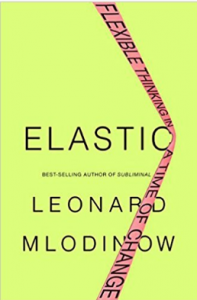I recently read “Elastic: Flexible Thinking In A Time of Change” by Leonard Mlodinow. Below are the quotes I found most interesting. If you like them, buy the book here.
 “The rational, risk-avoiding part of a person’s brain doesn’t fully develop until about the age of twenty-five.” (27)
“The rational, risk-avoiding part of a person’s brain doesn’t fully develop until about the age of twenty-five.” (27)
Logical thought can determine how to drive from your home to the grocer most efficiently, but it’s elastic thought that gave us the automobile.” (42)
For most situations, those who accept options that are good enough, rather than feeling compelled to find the optimal one, tend to be more satisfied with their choices and, in general, happier and less stressed individuals.” (56)
“Many recent studies in social psychology suggest ath monetizing creative output can disrupt the processes that lead to innovation.” (63)
“Offering an extrinsic reward for an intrinsically enjoyable behavior can be counterproductive. Difficulty in original thinking arises, says psychologist Teresa Amabile, when you “try for the wrong reasons.” (63)
“Women’s desirability ratings of the creative but poor men were strongly correlated with their degree of fertility, while fertility had no effect on their rating of the non-imaginative but rich men.” (64)
“When their fertility was high, 92 percent of the women chose artistic ability over wealth, but when it was low, only 55 percent did so.” (64)
“Cramond decided to administer what was essentially a test of elastic thinking to children diagnosed with ADHD and, conversely, to administer a test for ADHD to a group of children in a “scholars’ program.” She found astonishing overlap.” (65)
“When an ADHD brain comes upon a task it finds truly interesting – that is, a task that briskly stimulates the reward circuits – it obsesses over it and becomes hyper focused.” (66)
“I sometimes engage in a little mental flexibility exercise. I list some of my strongly held beliefs on slips of paper. I fold them, pick one, and imagine someone telling me that the belief written on it is false.” (94)
“Poet Friedrich Ruckert:
Each man faces an image
OF what he is meant to become.
As long as he does not achieve it
He cannot achieve his full measure of peace.” (116)
“If the act of walking or running can free your mind, so can taking a few minutes in the morning after you wake up to simply lie in bed. Don’t think about your schedule that day or ponder your to-do list but, rather, take advantage of your quiet state to stare at the ceiling, enjoy the comfort of your bed, and relax a little before popping up to face the world.” (126)
“When you reach an impasse, you may feel frustrated and be tempted to give up, but that is precisely the moment when, if you keep struggling, your ACC may kick into action and your most original ideas can being to surface.” (145)
“Research shows that sitting in a darkened room, or closing your eyes, can widen your perspective; so can expansive surroundings, even high ceilings. Low ceilings, narrow corridors, and windowless offices have the opposite effect.” (149)
“If you are striving for insight, interruptions are deadly. A short phone call, email, or text message can redirect your attention and thoughts, and once you are there, it can take a long while to get back.” (149)
“In life, once on a path, we tend to follow it, for better or worse. What’s sad is that if it’s the latter, we often accept it anyway – not because we’re afraid of change, but because by then we are so accustomed to the way things are that we don’t even recognize that they could be different.” (156)
“Scientists enlisted 119 patients in geriatric nursing homes. Their subjects had been taking an average of seven medications each day. With careful monitoring, the researchers discontinued about half the medicines. No patients died or suffered serious side effects from stopping the drugs, and almost all reported an improvement in health. Most important, the death rate among those in the study was far lower than that of a control group whose members had continued their medications.” (160)
“What we know can put a constraint on the possibilities we can imagine.” (168)
“Our conscious brains can process about forty to sixty bits per second, roughly the information content of a short sentence. Our unconscious has a much greater capacity. Your visual system, for example, can handle about ten million bits per second. As a result, your primary visual cortex can pass only a small fraction of that to your conscious mind.” (173)
“To have original thoughts, you have to let the ideas flow first and worry about their quality (or appropriateness) later. (183)
“The value of an idea can be difficult to ascertain, for it is one of the ironies of science and the arts that the brilliant and the nutty are not always easily distinguished.” (183)
“Ursula K. Le Guin is often quoted as having said, “The creative adult is the child who has survived.” (187)
“Belief in the supernatural declines as children mature and their lateral prefrontal cortex becomes more fully developed; conversely, in old age, as the vigor of the lateral prefrontal cortex declines and cognitive inhibition decreases, belief in the supernatural increases.” (193)
“You could be better at generating imaginative ideas if you do that kind of thinking after working on a chore that involves a period of tedious, focused effort that strains your powers of concentration.” (209)
“The nuns who’d been the most positive lived about ten years longer than those who’d been the least.” (211)
“Because negative emotion creates an instant focus on some particular behavioral response, it narrows the scope of possibilities that your cognitive filters allow through. As a result, a bad mood discourages elastic thinking.” (212)
Liked the quotes? Buy the book.

